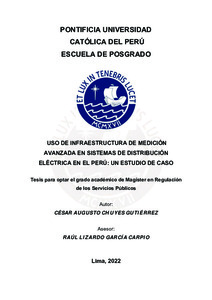| dc.contributor.advisor | Garcia Carpio, Raul Lizardo | |
| dc.contributor.author | Chuyes Gutiérrez, César Augusto | |
| dc.date.accessioned | 2023-02-20T19:45:17Z | |
| dc.date.available | 2023-02-20T19:45:17Z | |
| dc.date.created | 2022 | |
| dc.date.issued | 2023-02-20 | |
| dc.identifier.uri | http://hdl.handle.net/20.500.12404/24322 | |
| dc.description.abstract | En el presente trabajo se analiza la viabilidad de la implementación de
Infraestructura medición Avanzada (AMI) que consta de tres partes: medidor
inteligente (smart meter), sistema de comunicación de datos y la gestión de datos
obtenidos on line; como una herramienta que contribuye a mejorar la gestión y
calidad del servicio brindado, siendo una inversión que se justifica reconocer en
la regulación dados sus beneficios a los usuarios, tomando como caso de estudio
a Hidrandina S.A.
Si bien es cierto la calidad del servicio ha mejorado en la empresa en los últimos
años, es importante la aplicación de tecnologías que permita incrementar la
eficiencia y productividad que redunde en mejorar de forma sustancial la
satisfacción del usuario.
Con ello importante los beneficios de introducir AMI mediante su cuantificación,
así como los costos incurridos, de tal manera que se determine su viabilidad a
través de resultados costo beneficio, que incluye mecanismos de reconocimiento
de este tipo de inversiones en la regulación.
Importante las consideraciones de implementación y despliegue del AMI en
Hidrandina: por etapas, porcentaje por años, consumos bajos en algunas zonas,
tipo financiamiento, impactos por riesgos (regulatorios, sociales, financieros,
seguridad, etc) que aparecerían e importante y clave mitigarlos a través de un
plan integral de comunicaciones a los usuarios.
Precisar que los beneficios calculados para la distribuidora no son suficientes
para ser viable el proyecto, por lo que se requieren los ahorros y beneficios de
los usuarios para lograr esa viabilidad económica del proyecto. | es_ES |
| dc.description.abstract | In the present work, the feasibility of the implementation of Advanced
Measurement Infrastructure (AMI) is analyzed, which consists of three parts:
smart meter, data communication system and the management of data obtained
online; as a tool that contributes to improving the management and quality of the
service provided, being an investment that is justified in recognizing in the
regulation given its benefits to users, taking Hidrandina S.A. as a case study.
Although it is true that the quality of service has improved in the company in
recent years, it is important to apply technologies that allow increased efficiency
and productivity that result in a substantial improvement in user satisfaction.
With this, the benefits of introducing AMI are important through their
quantification, as well as the costs incurred, in such a way that their viability is
determined through cost-benefit results, which includes recognition mechanisms
for this type of investment in the regulation.
The implementation and deployment considerations of the AMI in Hidrandina are
important: by stages, percentage per year, low consumption in some areas, type
of financing, impacts due to risks (regulatory, social, financial, security, etc.) that
would appear and it is important and key to mitigate them through a
comprehensive communications plan for users.
Specify that the benefits calculated for the distributor are not enough to make the
project viable, so the savings and benefits of the users are required to achieve
the economic viability of the project. | es_ES |
| dc.language.iso | spa | es_ES |
| dc.publisher | Pontificia Universidad Católica del Perú | es_ES |
| dc.rights | info:eu-repo/semantics/openAccess | es_ES |
| dc.rights.uri | http://creativecommons.org/licenses/by-nc-sa/2.5/pe/ | * |
| dc.subject | Energía eléctrica--Perú | es_ES |
| dc.subject | Infraestructura (Economía)--Perú | es_ES |
| dc.subject | Análisis costo-beneficio--Perú | es_ES |
| dc.subject | Precios--Perú | es_ES |
| dc.title | Uso de infraestructura de medición avanzada en sistemas de distribución eléctrica en el Perú: Un estudio de caso | es_ES |
| dc.type | info:eu-repo/semantics/masterThesis | es_ES |
| thesis.degree.name | Magíster en Regulación de los Servicios Públicos | es_ES |
| thesis.degree.level | Maestría | es_ES |
| thesis.degree.grantor | Pontificia Universidad Católica del Perú. Escuela de Posgrado | es_ES |
| thesis.degree.discipline | Regulación de los Servicios Públicos | es_ES |
| renati.advisor.dni | 09951306 | |
| renati.advisor.orcid | https://orcid.org/0000-0001-9100-8056 | es_ES |
| renati.author.dni | 03497647 | |
| renati.discipline | 417697 | es_ES |
| renati.juror | Dammert Lira, Alfredo Juan Carlos | es_ES |
| renati.juror | Garcia Carpio, Raul Lizardo | es_ES |
| renati.juror | Rodriguez Gonzalez, Abel | es_ES |
| renati.level | https://purl.org/pe-repo/renati/level#maestro | es_ES |
| renati.type | https://purl.org/pe-repo/renati/type#tesis | es_ES |
| dc.publisher.country | PE | es_ES |
| dc.subject.ocde | https://purl.org/pe-repo/ocde/ford#5.06.02 | es_ES |







